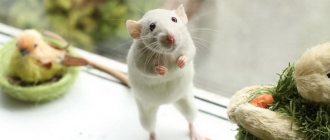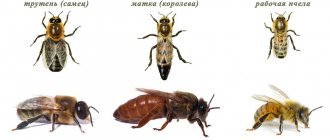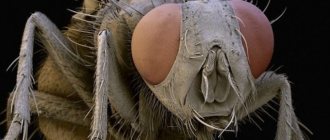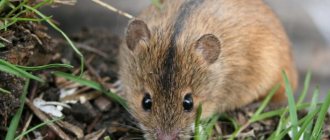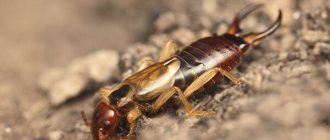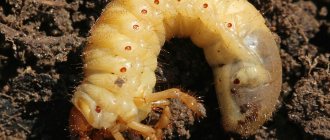Mice are small animals belonging to the class of mammals, an order of rodents from the mouse family.
They are found everywhere. The vast majority of their species live in tropical and subtropical forests, with fewer in the temperate and northern latitudes of Europe and Asia, as well as on the Australian mainland. There are approximately 13 species of mice common in the Russian Federation.
In total, the mouse family list includes 147 genera and 700 species. The size of the animal ranges from 5-48 cm, depending on the type of animal.
Below in the article we will try to describe what types of mice there are, how many species of them are found in Russia, what types of mice live where, and also provide their names, descriptions and photos.
Baby mice
They are one of the smallest rodents on earth. The size of an adult does not exceed 7 cm, the tail - 6-7 cm. The baby weighs no more than 10 g.
The appearance of the animal, namely its coloring, distinguishes it from other species. The fur of these mice is bright red in color, except for the abdomen, which is almost white.
Habitat: Spain, Korea, Japan, southern Kazakhstan, China and northern Mongolia. They are found in forests, fields and forest-steppe. In the summer they build nests in the grass, and in the winter they move into burrows, haystacks, and human dwellings.
Baby mice quickly adapt to their new environment. They are quite peaceful and calm. They can live in captivity. At the same time, the animals need a large, capacious cage or a small terrarium so that the little ones can move and climb freely.
In food, it prefers seeds, cereals, legumes, and small insects.
How does a mouse reproduce?
Even rabbits will envy the fertility of mice. The intensity of reproduction mainly depends on the ambient temperature, and of course, on the amount of food. So, in wild, natural circumstances, mice breed exclusively in the warm season - from early spring to late autumn. But in the comfortable conditions of human possessions, in consistently warm rooms or haylofts, they do not take a break for the cold winter and breed all year round. Less than a day after giving birth, the female is ready for new mating and fertilization. On average, a female mouse gives birth 8-10 times per year, bringing ten or even more cubs.
Little mice:
- develop in the womb for about three weeks (full cycle of embryogenesis);
- 10 days after birth they become covered with fur;
- after 2 weeks – eyes open;
- 3 weeks old - leaves mother;
- by the 7th week of life they become sexually mature individuals.
They are born as tiny, naked and blind creatures, and in less than 2 months they are already full-fledged mice, ready to give birth.
The rather rapid maturation is explained by the relatively short lifespan of mice under natural conditions – up to one and a half years.
House mouse
The ability to get along with humans has made these animals the most common species of the mouse family and the most numerous of the mammals on earth. Distributed everywhere. The Far North, Antarctica, and highlands are places where these rodents are absent due to low temperatures and high humidity.
These mice are perhaps the smallest representatives of their family, if you do not take into account the tiny mice. The length of their body is no more than 10 cm, the tail is 5-10 cm. The animal has gray fur on its back, sides and a light belly. House mice that live in desert areas are sandy yellow in color, while domesticated house mice are white.
Unlike wild rodents, white decorative mice often become pets. In addition, they are bred in laboratory conditions as food for serpentarium pets, as well as for clinical studies as experimental animals.
In nature, rodents live in burrows. With the onset of autumn, they begin to move into residential buildings and outbuildings.
The main diet is seeds, grain, green parts of plants, and once in a person’s home, they sweep away everything that comes their way - from bread crumbs to soap and candles.
Types of mice with photos and names
The main description of the animal for all types: small weight and size. The color, ear shape and tail length are different. More than 300 species of mice have been recorded in the world. Two thirds of the list of varieties are common in warm countries such as Africa and Asia.
The breeds that people most often encounter, in addition to domestic ones:
- all varieties of voles;
- steppe and yellow variegation;
- mole vole;
- forest and field mice.
Depending on the climate, the types of domestic mice do not change, but wild ones are different. Thus, the little ones prefer to choose areas with warm winters, and voles are found in the Caucasus and Siberia.
Interesting fact! All types of mice constantly chew on something. The reason for this phenomenon is not hunger at all. The rodent has long teeth that grow 1–2 mm daily. For ease of movement and a comfortable existence, mice need to wear them down regularly.
Baby
The name says it all: a species of overly small rodent. The size of an adult reaches a maximum of 7 cm. The tail is equal to the length of the body. It belongs to the wild breeds, as it lives exclusively in nature. The nest is built from branches and grass. It moves well through trees thanks to its tenacious legs and sharp claws. The tail helps in moving along vertical surfaces.
Does not hibernate. Safely tolerates severe frosts. You can determine that a mouse is small in front of a person not only by its size:
- Color – red, as close to yellow as possible. Because of this feature, the baby is called a yellow mouse.
- The coat differs on the tips of the ears, belly and muzzle - dirty or yellow-white.
Habitat: England, Caucasus, Yakutia. It is a herbivorous species, but insects and worms are quite suitable as food. Farmers most often encounter this type of mouse, as the little one seriously damages garden crops, trees, and crops.
Wood mouse
Habitat: forest, densely planted plantings, mostly edges. Second name: wood mouse. Description of the species:
- color: dark red, brown, black;
- length: 8–10 cm;
- tail no more than 6–7 cm;
- A distinctive feature is large round ears.
Uses abandoned tree holes as a home. For wintering, it builds a deep burrow (up to 2–2.5 m deep) and stores huge reserves of food. The first emergence of a wood mouse indicates a long thaw.
It is not dangerous for humans, unless the forest zone borders on vegetable gardens and orchards. Capable of ruining the harvest in the field.
Gerbil
The rodent is native to the USA. It came to the territory of the post-Soviet space as an experimental creature. The appearance is very cute, even attractive. Therefore, this species quickly began to be considered decorative. Suitable as a pet. Keeping the animal is not difficult, and the food is simple: cereal sets, cheese, vegetables and fruits.
The gerbil does not have a specific mouse smell. The view is varied. There are up to 150 varieties. The most common were: Mongolian mouse and dwarf mouse.
Appearance:
- tummy – white;
- back with a bright black stripe;
- color: brown-red interspersed with black hairs;
- tail with a tassel;
- ears are round, small;
- nose: small pink;
- distinctive feature: large eyes.
Steppe mouse
A frequent enemy of farmers. In appearance, it resembles a gerbil, but does not have stripes on its back. Small: 5–7 cm in length. It differs from the mass of mouse species in the tail part, since it is 2 times larger than the body. Plus, he leads an active lifestyle during the cold season. Traces can be found wherever a rodent is looking for food. This often misleads ordinary people that it is not a mouse that lives in the marked place, but a rat.
It builds burrows closer to bodies of water with dense vegetation and bushes. In some reference books, the steppe mouse is classified as a species of vole.
House mouse
The house type of rodents is found in all parts of the globe, since they do not live outside. The main goal: to settle closer to humans for abundant nutrition. Color of the species: gray, almost earthen. In the warm season, it builds burrows close to housing, since food is available everywhere. But with the approach of cold weather, it quickly moves into apartments and houses.
He does not try to make reserves for the winter, since this is not necessary. Everything is suitable for food: furniture, grain, soap, clothes, interior items. Moves quickly. Able to settle down on the upper floors. Damages wiring and electrical wires. The house mouse thrives in cars where there are wires, upholstery, and non-metallic elements.
Description:
- ears: small, round;
- body: 6 cm;
- tail: 1–2 cm larger than the body.
The house mouse got its second name - gray-humped - because of its color. But in everyday life there are two types. They differ in color: gray and black. There are no other differences.
White mouse
The white long-eared rodent is not a specific species, but a genetic failure. The white breed is found in all forms. The color is uniform, can be diluted (rarely) with another color (gray, black, brown). Albinos most often have red eyes. Used for laboratory research. Such a representative is also purchased as a pet.
Important! Mice are carriers of numerous diseases, including those that are difficult to cure. If you purchased a rodent as a pet, then it remains one of the threats to infection. The risks of infection are reduced if the mouse is provided with proper care and the cage and housing are disinfected.
Ground mouse
Common name: ground rat or water vole. The rodent is similar in appearance to the second species, but larger in size (up to 25 cm). The tail and body are the same length, often the tail part is longer. Prefers marshy areas.
The coat is thick, including the tail. We can say that the animal is fluffy. Color: dark grey. They pose a threat to people in the form of damage to garden and field crops. When they meet, they try to quickly hide. It is not recommended to pick up or breed at home, since the earth mouse is a carrier of tularemia, Omsk and hemorrhagic fever.
Spiny mouse
A special type of rodent, as it combines the characteristics of several animals:
- capable of throwing off its tail like a lizard if life is in danger;
- physiology like mice;
- the presence of small needles in combination with wool.
It differs from mice in the gestation period: 42 days. There can be a maximum of 3 mice in a litter. Throughout the year, mating occurs only from the end of February until the onset of cold weather, which significantly reduces the population of the breed.
After the birth of the offspring, the mother takes care of the young for no more than 2 weeks. However, she does not go out hunting or for walks. Only after 14 days does the female begin to introduce the mice to the environment. This phenomenon is not characteristic of the mouse family.
Habitat: akomis or spiny mice are common in Western Asia, savannah. They live in burrows. They prefer to settle in rocky and sandy areas. Suitable for home breeding, as they do not have a mouse smell, like voles.
Need to know! You should not use homemade devices to catch mice. Especially if they involve current. Experts recommend using numerous humane options for eliminating rodents from a house, apartment or summer cottage.
Yellow-necked mouse
They inhabit the southern part of Russia. The species was noticed at the end of the 19th century. But in 2008 it was included in the Red Book. Despite its rapid reproduction, the species was exterminated very quickly. If it is difficult to notice a gray or black mouse right away, then the yellow-throated one is given away precisely by its color: bright red. Distinctive feature: large yellow stripe on the neck. Body length: 8–10 cm, large ears.
It chooses nuts, acorns, and beech (seeds) as food.
Rodents in general are pests of noble crops. But this is due to the need to feed the offspring. At the same time, mice are suitable as a pet, which, instead of causing harm, will delight children and adults with simple antics. Which species are suitable as a pet animal is clear thanks to the description and characteristics of the selected variety.
Harvest mouse
Habitat: Central and Eastern Europe, the southern part of Western Siberia, China (except for the south), Mongolia, the Korean Peninsula, Taiwan. This type of rodent rarely lives in houses and outbuildings, unlike house mice.
The field mouse prefers open areas - bushes and fields. In megacities it mainly lives in green zones. Lives both in burrows and other natural shelters. Rodents that live in swampy areas build nests in bushes or grass.
The body length of the animal can reach up to 12.5 cm, the tail – up to 9 cm. The color of the field mouse is grayish-brown, with a dark stripe running along the back.
The animal’s diet, which changes depending on temporary conditions, is based on plant foods and insects. Field mice are the largest pests for agriculture and forestry, and they can also live in country houses.
Description and appearance
So, who is this mouse? Mice are animals belonging to the rodent order and the mouse family. Regardless of the species, all mice are distinguished by their small size and anatomical features, namely, the presence of an elongated, pointed muzzle, a dense body, a long tail, short paws with movable fingers and tenacious claws.
Mice live all over the planet, often settling near people. Some species are classified as synanthropic.
How does a mouse skeleton work?
The mouse skull is oval, with clearly visible areas of bone fusion. Rodents have a well-developed lower jaw, which can move in different directions.
Skeleton
The mouse skeleton is light, mobile, elastic, but at the same time very durable. The neck consists of 7 vertebrae connected by a column, and there are 20 in the tail. The pubic bones of mice are connected by ligaments. Due to this, during childbirth the bones move apart and females can give birth to rather large (compared to the size of the mother) mice.
Features of teeth
The structure of a mouse's teeth is very unusual. The front incisors (2 upper and 2 lower) do not have roots and grow throughout the life of the rodent. Therefore, animals constantly have to gnaw on something very durable in order to wear down their teeth at least a little. If this is not done, the mouse will not be able to close its mouth and eat normally.
Mice have no fangs. The molars, located on the sides of the jaw, have an uneven surface. It is with their molars that rodents grind food that gets into their mouth.
Sense and smell organs
As for the senses, mice have rather poor vision, acute hearing and an excellent sense of smell. The eyes of mice are rather poorly developed; most individuals have severe farsightedness. Rodents see best in twilight, but in complete darkness they navigate with the help of sensitive vibrissae.
Mice hear very well. Their ears can even perceive ultrasound. Rodents' sense of smell is also excellent; it helps them search for food, recognize relatives and navigate the area.
Wool and color features
The body of mice is covered with thick, smooth fur. Features of coloring - on the belly the fur is lighter than on the back and sides, and the border is quite clear. The color of wild mice varies from sandy to dark brown, almost black. The most common colors are gray, brown, red. Sometimes there are stripes or spots on the skin.
It’s interesting that the further south a mouse lives, the lighter its fur.
Dimensions and physiological features
Depending on the species, the size of mice varies from 6 to 18 cm, but the vast majority of rodents grow to 8 – 11 cm. The length of the tail can range from 60 to 100% of the body length, in some individuals the tail is even slightly longer. How much an animal weighs depends on its size. The average weight of a mouse is about 20–25 g.
The average body temperature of mice is +37.5…39⁰С. A rodent's heart beats at a rate of about 600 beats per minute. Mice run quite fast, many varieties can swim, but they do this only when absolutely necessary.
Differences between male and female
Sexual dimorphism in mice is not pronounced. It is impossible to distinguish a male from a female either by size, weight, or color. There may be some differences in character. According to studies, females are calmer, while males are more likely to show aggression.
Reproduction and lifespan
The mouse is a polygamous animal. Males and females do not create families and disperse immediately after mating. Rodents reach sexual maturity at three months of age. Pregnancy lasts 18–22 days, after which 3 to 10 pups are born. The cubs are born completely helpless. They have no fur, ears and eyes are closed.
With little mice
Mice are mammals. The female feeds the mice for the first 3 weeks after birth. In the fourth week of life, the pups become independent. Mice can breed all year round. During the year, the female brings from 3 to 9 litters.
Typically, the lifespan of a mouse in nature is 1.5–2 years, but in general rodents can live 5–7 years.
Wood mouse
The animal prefers natural shelters, its own or others' burrows in floodplains, in thickets of meadow bushes, and in open areas of forest. Their habitats are broad-leaved and mixed forests of Eastern Europe, Turkey, the Caucasus, Kazakhstan, Altai.
It reaches 10 cm in size. The length of the tail is approximately the same as the length of the body. Color – grayish-red. Some individuals have a yellow spot in the chest area.
Rodents, as a rule, feed on plant foods (grain, seeds), and do not refuse insects. They eat young tree seedlings, causing severe damage to forestry.
What is a "mouse"?
A “mouse” is a push-button manipulator designed together with a keyboard to enter information into a computer.
Indeed, he looks like a mouse with a tail. A modern computer is already unthinkable without this thing.
The “mouse” is much more convenient to use than, for example, the built-in manipulator of a laptop.
Therefore, users often disconnect this laptop “pad” and connect the “mouse”.
How does this convenient thing work?
Vole mouse
Distinctive features of this type of rodent are their short tail, small ears and small muzzle. The length of the mouse's body, not including the tail, is 12 cm. The color is gray or dark brown, the abdomen is gray.
Habitat: North Africa, Middle East, northern India, southwestern China, Taiwan, Japanese Islands, North America.
Like a mole, the vole digs deep, multi-pass burrows. The animals are active at night and are underground during the day. They feed on plant foods - green parts of plants, roots, tubers.
You can try to fight small rodents using ultrasound.
Types of computer mice
Displacement sensors have evolved the most over time, structurally representing:
- Direct drive - two perpendicular wheels protruding from the body; when the mouse moved, the wheels rotated each in its own plane.
- A ball drive is a rubber-coated steel ball protruding from the body, which, when moving, transmits movement to two rollers pressed against it, located in two planes, which transmit information to rotation angle sensors, which transform these movements into electrical signals.
- Optical drive:
- 1st generation optical mouse – a mouse in which optical sensors directly monitor the movement of the working area relative to the mouse. They required special rugs, a certain orientation relative to the rug.
- The 2nd generation optical mouse is a mouse with a matrix sensor, with a special video camera at the bottom, which constantly takes pictures of the working surface and, comparing them, sets the course and parameters for moving the mouse. Sensitive to surface texture.
- An optical laser mouse is a mouse with a more advanced type of optical sensor that uses a semiconductor laser.
- Gyroscopic mice are equipped with a gyroscope that recognizes movement not only on a plane, but also in space.
- Induction mice – a special mouse pad is used that operates on the principle of a graphics tablet, or they are included in a graphics tablet.
Mouse buttons are used to perform the following manipulations: selecting an object, moving. Mice come in one-button (Apple), two-button and three-button types. Some models contain additional buttons used to configure the mouse, double-triple clicks (for programs and games), and other purposes - individual system functions, such as launching applications, are specified in the driver; double tap; horizontal scrolling; control the volume level and playback of video clips and audio tracks; navigation in file managers and browsers.
At the end of 2009, Apple introduced a mouse with the first touch control; instead of buttons and wheels, it uses a touchpad, which allows you to scroll, zoom, and transition using various gestures.
Optical mice
Subsequently, the manipulator was improved.
The so-called optical “mice” appeared.
Such devices contain an emitting LED (usually red), a transparent reflective plastic prism, a light-sensitive sensor and a control controller.
The LED emits rays that, reflected from the surface, are captured by the sensor.
When the manipulator moves, the flow of received radiation changes, which is captured by the sensor and transmitted to the controller, which generates standard signals for a specific interface. An optical mouse is more sensitive to movement and does not require a mouse pad like the old ball pointing mouse.
An optical mouse has no rubbing parts (with the exception of the potentiometer, the rotation of which is transmitted from the scroll wheel) that wear out or become dirty. This is also an advantage.
Mouse - description
These small rodents are distributed throughout the entire earth, excluding the extreme northern and high-mountain regions. The closest relatives of mice are jerboas, mole rats, hamsters and dormice. And more distantly related are rats, chinchillas, porcupines, beavers, and guinea pigs. In total, the Mouse subfamily includes 121 genera and more than 300 species.
The mouse is a small animal with an elongated and pointed muzzle, large round ears and bulging beady eyes. A long, hairless or slightly pubescent tail is a distinctive feature of the animal. The limbs, which are not the same in length, are adapted for digging and moving along vertical and horizontal surfaces. The body length of a rodent can vary from 3 to 20 cm, weight - from 15 to 50 g.
Mice have a special bite. On the lower and upper jaws the animal has 2 chisel-shaped teeth, which are continuously growing. Rodents are forced to constantly grind them down, which is why their incisors are very sharp.
Animals from the Mouse family have good eyesight and can distinguish between red and yellow shades. The usual body temperature of these rodents ranges from 37.5 to 39⁰C. The maximum lifespan of mice is 4 years.
